THE POTHOLES: QUARRY OR CAVES? A CONSERVATION BATTLE
ABSTRACT
The Potholes Area, Murrindal, Victoria, contains many of Victoria's deepest and most beautiful caves, in one of the most intensely caverniferous areas in Australia. The caves and surrounding karst landscape provide some of the most intensively used recreation caves in Victoria. There is at least one cave worthy of commercial tourist development. For 20 years the Victorian Speleological Association has lobbied to prevent quarrying of a portion of the area. The land affected by the Extractive Industry Licence has now been acquired by the State Department of Conservation, Forest and Lands. The history of land use, caving, the conservation battle and future management directions of the area is discussed.
INTRODUCTION
The Potholes Area of Murrindal is situated on the ridge forming the divide between the Buchan and Murrindal River valleys some 8 kilometres north of Buchan in East Gippsland, Victoria (Figure 1). The area was so named by cavers because of the numerous vertical caves in the area. The surface karst has more than 50 dolines up to 50 metres across and up to 10 metres deep (Figure 2). These dolines, many with entrances to caves, are concentrated in a very small area. The significance of the area is for its high density of karst features and caves which is higher than for other karst areas in Victoria and the whole of South Eastern Australia.
This paper describes settlement and alienation of land in the area. Reservation of particular areas for their landscape and cave values is discussed in relation to subsequent cave exploration and the conflicts with economic uses of the limestone for quarrying. In particular, the history of Extractive industries Licence No. 527 in Allotment 22A, Section B, Parish of Buchan is discussed.
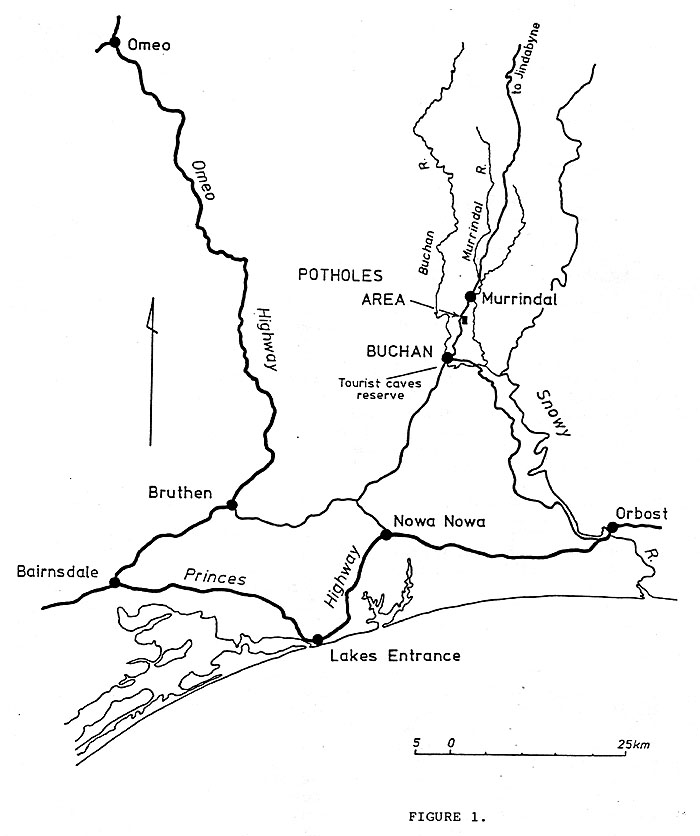
Figure 1
EARLY HISTORY
Buchan was settled from the Monaco district of New South Wales in the early 1840s. The area taken up was the more fertile land which occurs on the limestone. The infertile land consists of the Snowy River Volcanics and even today very little is used for agricultural purposes. Caves did not receive particular attention in the Buchan Area until Stirling, the Government Geologist, reported and described a number of them in 1889 (Stirling, 1889). The caves described by Stirling were not in the Murrindal Area. It was not until 1900 that Mr A.E. Kitten reported further areas with cave and karst values in relation to lands which should be reserved for these values. His full report published in 1907 (Kitten, 1907) led to the reservation of some 7 separate areas for their caves' values. These included the Buchan Cave Reserve on the Murrindal River; the area around the Murrindal and Lilly Pilly Caves on the Murrindal River at Murrindal; the Dickinson's Cave Reserve; Slocombe's Cave at the Basin and the reserve in the Potholes Area discussed further below. These Reserved Areas were vested in the Department of Conservation Forests and Lands. Active management of these Reserves, until recently, has been concentrated on the Reserve at Buchan although Wilson's Cave and the two caves, Murrindal and Lilly Pilly, were developed and shown to tourists until the 1930s.
With regard to the Potholes Area, Mr Kitten's report in 1900 recommended that "the whole of the Camping Reserve in Section B of the Parish of Buchan comprising 18 acres, 2 roods, 29 perches and situated between Allotments 18, 19, 22 and 24 and also such portion of the adjoining Allotment 22A, as would be found by survey to be desirable be made a Cave Reservation". In reference to Allotment 22A he also states: "Exploration will doubtless reveal numerous caves in this locality". Subsequent exploration and discoveries are discussed further below.
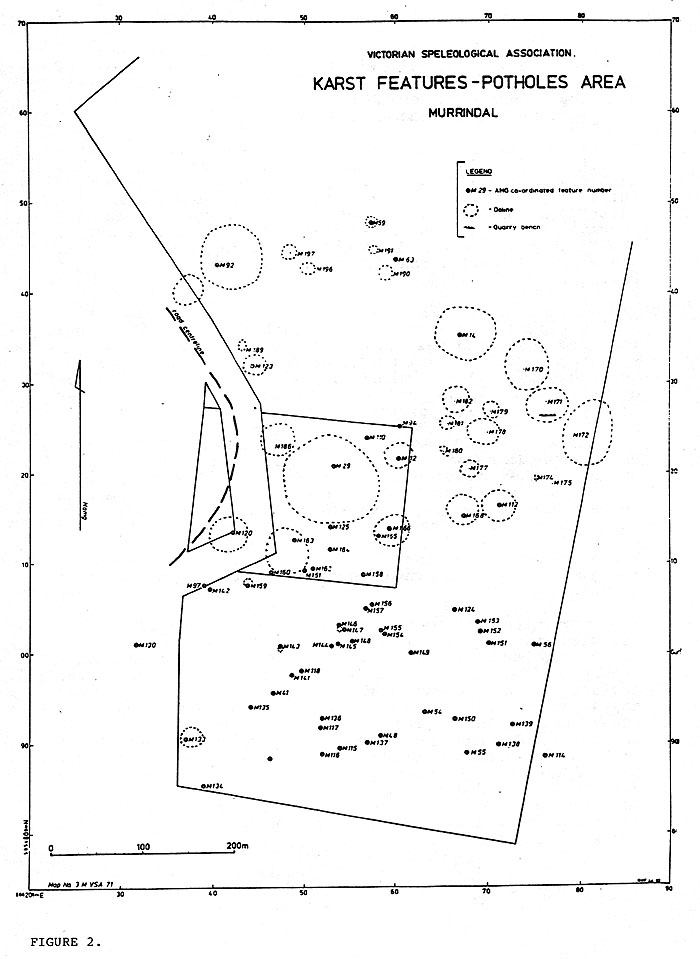
Figure 2
An area of 10 acres, 0 roods, 39 perches was surveyed in Allotment 22A, Section H, Parish of Buchan and was reserved as a "Temporary Reservation for Public Purposes and the Protection of Natural Features" on the 31st December, 1901 (Government Gazette, 1901).
This area was a minimal reservation owing to objections to resumption by the then owner, a Mr Biggs, and directive for the Department of Crown Lands and Survey to the surveyor that the survey be made so as to cause the least possible injury to Mr Biggs (Crown Lands and Survey). It should be noted that there was a covenant to the Title allowing the land to be resumed by the Crown at the cost of alienation if future discoveries warranted this.
In the course of consolidation and re-enactment, this reservation was revoked on the 14th December, 1938 and the land concerned was included in the Reservation of 863 acres, 1 rood, 1.3 perches gazette on the 14th December, 1938 covering all of the caves reservations in the Buchan district and known collectively as the Buchan Caves Reserve (Government Gazette, 1938).
The portion of Allotment 22A included in the Reservation has since decreased to 6 acres, 2 roods, 37.6 perches owing to the excision of part as a Road Reserve, thus leaving a small area of 1 acre, 1 rood, 26.1 perches between the two roads, with the balance being located on the Eastern side of the road.
The relationship of these Reserves to freehold allotments are given in the attached map showing tenure and reserves (Figure 3).
The provision for preservation of caves and landscape features of the region through gazette reservation of lands was and is still based entirely upon Kitten's report of 1900 and the knowledge of that day. Subsequent exploration now shows that most of the most important caves and karst features lie outside the gazette reserves. Even where the present reserves include entrances of important caves, the underground extent of these often extends beyond the reserve boundaries. In the case of Potholes Area, many deep caves and distinctive land forms are outside the reserve, and while the entrance of the beautiful cave Exponential Pot is contained within the reserve, the cave extends at least 50m beyond its boundary.
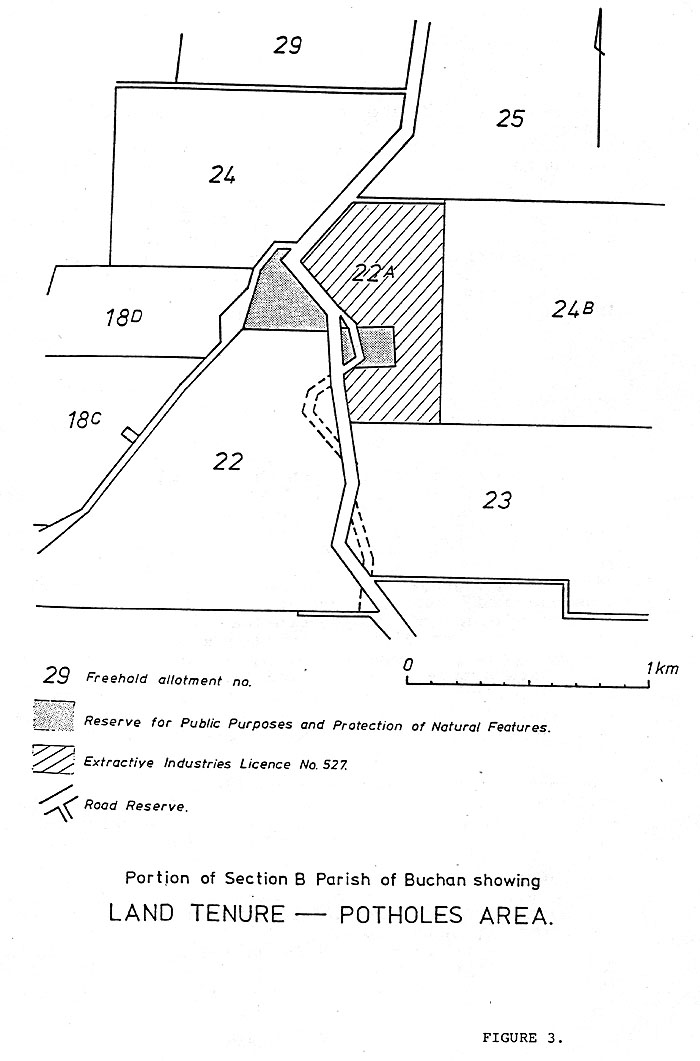
Figure 3
THE POTHOLES AREA
The landscape of the Potholes Area has many collapse sinkholes. Most of the caves are located in very minor depressions as the larger sinkholes contain too much rubble to give access to the caves beneath. The Area is located on the ridge forming the divide between the present courses of the Buchan and Murrindal Rivers. There is little or no surface runoff except at times of excessive rain as all water flows into the sinkholes and caves. Outflow caves are known at river level at the Pyramids to the east and at Scrubby Creek to the west. It is not known in which direction water flows from caves in Allotment 22A, but perhaps it goes both ways.
A brief resume of the geology and geomorphology is pertinent to both an understanding of the caves and the economics of quarrying.
The limestone is early Devonian (400 million years old) and this overlies the Snowy River Volcanics. The Buchan Group limestones are of shallow marine origin. The Buchan Caves Limestone was formed first and is overlain by the Murrindal Limestone and the Taravale Formation. The lowest portion of the Taravale Formation is the Pyramids Marlstone and consists of beds of calcareous marlstone and fossiliferous calcareous nodules. In the northern part of the Potholes Area the Murrindal Limestone can be divided into the McLarty Limestone and the Rocky Camp Limestone and these are overlain by the Taravale Marlstone (Teacher and Talent, 1958). The Rocky Camp Limestone is very pure calcium carbonate and suitable for high grade uses whilst the clarity limestone is less pure having siliceous stylolites throughout the rock.
The rocks of the Taravale Formation outcrop is Allotment 22A and a cross section is shown in Figure 4 together with a sketch showing the major joint directions which have affected cave development in the Potholes Area.
Cave exploration of the Potholes Area started in the 1950s and became more systematic with the formation of the Victorian Cave Exploration Society in 1957 and the Victorian Sub Aqua Society in 1960. It was in December 1957 that Ken Lynn of VCES referred to the 18 Acre Camping Reserve as the Pothole Reserve. In October 1958, Robin Bailey in VCES Special Report No 1 described the area as "The Potholes Area" and described caving in Ml, M5 and M6 on 19th April 1957. The area has been known in caving circles as this ever since and has been used in submissions to Government and in the caving literature to refer to all caves in the Allotments, Road Reserve and Reserved Areas in the vicinity of Allotment 22A as the Potholes Area. The two original clubs had explored and numbered 89 caves in the Murrindal sequence of numbered caves in 1968 but these also include caves at Murrindal, at Scrubby Ck and at the Pyramids (Matthews, 1968). The two clubs amalgamated in 1967 to form the Victorian Speleological Association. By 1985 there were 259 described caves and features in the Murrindal area and most of the new numbers are in the Potholes Area (Matthews, 1985). The major caves of the Southern Portion of Allotment 22A are shown in plan in Figure 5 and some typical cross sections of some of the deeper caves are shown in Figure 6.

Figure 4
Knowledge of the caves of the Potholes area has built up as cavers continued to make new discoveries, however, geomorphic interpretation has been rather simplistic until the recent work of Webb et al (in press). The caves of the Potholes Area were developed vertically along joints and often appear maze-like in plan. They are of nothephreatic origin and are limited at about 70 metres depth by the underlying insoluble Taravale Formation. The development of the caves was along joint systems and due to slow moving groundwater. This occurred before the down cutting of the present Buchan and Murrindal Rivers. Webb et al (in press) give a date of 38 to 42 million years based on basalt flows which covered the area from the Potholes to Gelantipy (Wellman, 1974). The Potholes Area and its caves thus provide important evidence of extremely old cave systems and their study and interpretation can contribute a lot to the geomorphic interpretation and evolution of the southeastern part of the continent.
EXTRACTIVE INDUSTRIES AND CONSERVATION HISTORY
The first usage of limestone from the Buchan area was as building stone. Several small quarries have been exploited for cut stone purposes; the main such quarry was Cameron's Quarry at South Buchan. Stone from this quarry was used in a number of Melbourne's public buildings such as the National Museum the Public Library and the Shrine of Remembrance. Stone from this quarry was used in the late 1950s for paper manufacture by APM at Maryvale. Talent (1958) described the quality and occurrence of quarryable limestone in the Buchan Basin.
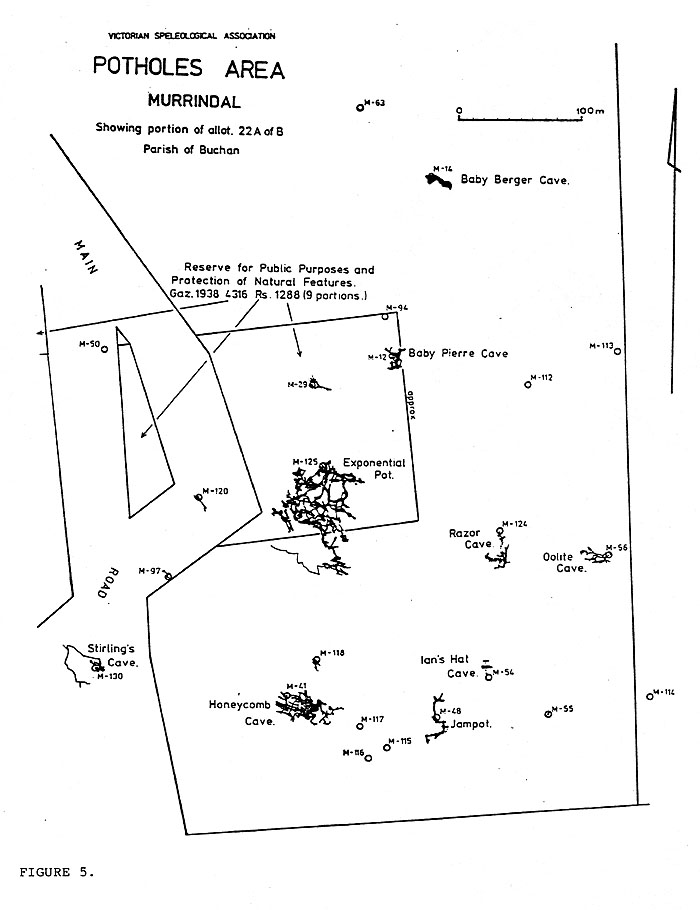
Figure 5

Figure 6
The most significant deposit of Rocky Camp limestone situated at Rocky Camp was developed by APM to supply their paper mill at Maryvale. In the last 5 years the quarry has been managed by Mitchell Estates and considerably larger tonnages are being produced and used for a wider range of uses. This quarry exists on a hill with virtually no caves on it. Talent described a number of other economic prospects for the whole area. L & K McRae in 1969 applied for an Extractive Industries Licence at East Buchan which was objected to by VSA. This licence was never granted.
The Rocky Camp limestone in Allotment 22A was first looked at by BHP in the late 1950s. Apparently they mapped the outcrop and defined its boundary with the MacLarty Limestone and did some test drilling but this did not lead to economic development. In January 1971, L & K McRae applied for Licence No 527 over Allotment 22A. VSA lodged objections to the granting of this licence and listed the extent of the caves known to us at the time and the values of these caves and the area as a whole. VSA was advised by the Secretary for Mines that our objections would be considered before any granting of the licence. In March 1971, Altarama Minerals were conducting the evaluation of the application and VSA visited the Allotment with geologists of the company and showed them the beauty and extent of Honeycomb Cave. Further correspondence was undertaken with the Secretary for Mines, stating our basic premise that the area was too valuable to be quarried. This led to an invitation from the Secretary for Mines to provide further information. We were now in possession of detailed quarry plans which allowed us to develop our objections in more detail Our major proposal was that a "Honeycomb Peninsula" be proclaimed and be excluded from the licence. In July 1972, the Extractive Industries Advisory Committee advised the VSA that our objection had merit and the "Honeycomb Peninsula" proposal was accepted and that the area would be excluded from the licence. The effect of the decisions of the Advisory Committee were to considerably reduce the tonnage of limestone available for quarrying.
Altarama Minerals proceeded to evaluate the resource and conducted a drilling program on the Allotment. As far as we could ascertain from examining drill cores there was a lot of hollow ground under the surface which did not correspond with caves known to us. These hollows were also associated with considerable impurities derived from the terra rossa residual of the Taravale Formation. Both these factors severely affected the viability of the whole proposal on both safety and economic grounds.
Cavers stepped up their exploration activities and their surveying and documentation of the caves in the Allotment over the next few years. The most significant finds were Exponential Pot and Razor Cave. Exponential Pot was discovered in 1973. It is some 2 kilometres in length and is extremely beautiful. The entrance is within reserve but it extends south out of the reserve and towards Honeycomb Cave (Figure 7). This cave proved central to my contention that it had sufficient interesting passage, different levels and had such profuse and diverse formation that it deserved protection and consideration as a future show cave. The VSA constructed a gate over the entrance of the cave within a month of its first discovery.
During the next couple of years there were changes in the perception of values of natural features. The Whitlam Labour Government conducted the National Estate inquiry and followed this by the passing of the Heritage Act. Both the ASF and the VSA were active in these moves. VSA on two occasions applied for funds for studies of caves and karst values in the Buchan Area and included in these propositions that funds be provided for acquisition of areas found so valuable for their cave and karst values that they belonged in public ownership. Neither of these proposals was funded.
The next real events occurred in 1979 when the McRaes started activities that looked like quarry operations were soon to be started. The VSA immediately prepared a new document on the area. This was a document of some 30 pages describing the area and its importance in National Estate terms and for recreation and tourism. It described the new caves and explained how a quarry would destroy some caves and affect integrity of the area for all these values. This was submitted to a number of Government Ministers and called for the revocation of the Extractive Industries Licence and for the owners to be compensated. This submission must have caused a lot of consternation in Government. It resulted in a conference between the McRaes, the VSA and a number of relevant Departments. This meeting was quite acrimonious since the VSA had obviously seriously affected the quarry operation in both its possible size and also on the costs of operation, since it was proposed that limits be placed on type and quantity of explosives which the operators were permitted to use.
The meeting led to an exchange of further information on the amount of compensation the operators would be prepared to accept. This figure was based on the expenditure incurred to date and value based on inferred royalties. A figure close to $250,000 was the best that could be deduced compared to a value for the land itself of about $10,000. This was clearly beyond the resources of cavers to raise and the Government was not interested either. The quarry development that occurred was the erection of two sheds, the excavation of a small test bench of some 15 metres across and a small dam. Only a couple of tonnes of stone were removed. The operators were not given an operating licence for the quarry and this prevented them proceeding with the quarry.
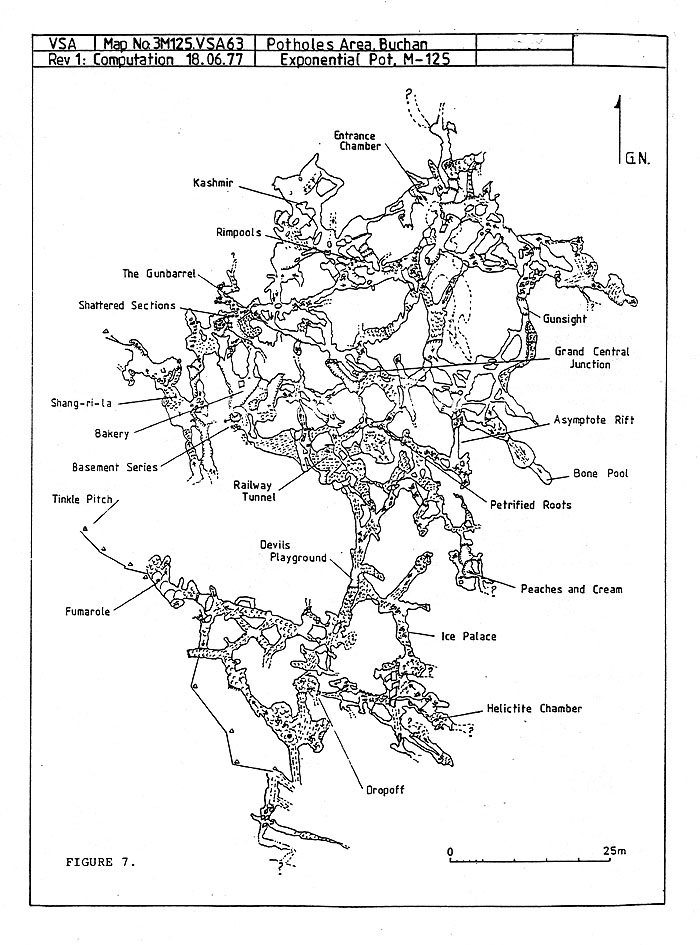
Figure 7
The Ministry of Conservation under its program of identifying sites of scientific interest conducted a study of geological and geomorphologic interest in East Gippsland in 1981 (McRae-Williams, 1981) This study documented the Buchan Area caves and karst and placed high values on a number of localities. The Potholes Area was rated of national significance and the report stated that "The area contains the best example of doline karst topography in south-eastern Australia. In addition this area exhibits the best examples of joint controlled cave development in Victoria and also some of the best decoration in the Buchan area."
The VSA made a long submission to the Land Conservation Council when it considered the Gippsland Lakes Hinterland Area (Land Conservation Council, 1986). The recommendations did not improve the situation with regard to the Potholes Area but it made a number of recommendations concerning the values of caves and the responsibility of public land owners regarding cave management of caves in their jurisdiction. For instance, caves on or within river reserves were to be managed as if they were formally within gazetted Cave Reserves.
At the 1983 Victorian Cave Tourism and Management Conference the next major step forward was taken when the Minister of Conservation Forests and Lands agreed to set up a Caves Classification Committee. This was duly set up and amongst the terms of reference were the compilation of a catalogue of Victorian caves and to advise on ways of more effectively protecting caves on private land, including any recommendations for acquisition of land. The report (Davey and White, 1986) commissioned by the Committee on behalf of the Government classified Victoria's caves, and the consultants also recommended the acquisition of Allotment 22A. Details of this committee's activities were presented at the last conference of this Association (White, in press)
During 1987 it became apparent that Allotment 22A was on the market. Steps were taken by undisclosed friends to purchase the property on behalf of the Brimstone Co-operative. No meaningful response to genuine bids was forthcoming in early 1988, the Department of Conservation Forests and Lands also became interested in such a purchase as a result of lobbying and the advice of the Caves Classification Committee. The Department was initially rebuffed and the Minister, The Honourable Joan Kirner, was persuaded to sign an acquisition order which was duly served on the owners. Subsequent negotiations on the terms and amount of compensation took a long time. Finally, we were advised that settlement had taken place in early February 1989 and the Department had title to the Allotment. This settlement included compensation for the sheds and for the limestone. I was able to enter Razor Cave in the first week of February 1989 without the fear of being prosecuted for trespass.
CONCLUSIONS
This battle has taken 20 years to win. Now comes the equally difficult task of managing the caves and karst. The caves are intensively used recreationally and management must involve these users in developing appropriate strategies and plans for this valuable resource. Most of the significant caves are now in public ownership, however, each of the adjacent Allotments is also part of the doline field and all contain some caves. Eventually, the karst and the caves in these Allotments should all receive sensitive and sympathetic management of these features in conjunction with those in public ownership, but this is not to say that these Allotments should be acquired or that the existing primary production should not continue. Buchan has been named a hub for tourism development in the recent Far East Gippsland Tourism Strategy (Gordon, 1988). Recreational cavers provide a significant proportion of visitors to the area and much of their caving is in the Potholes Area. The numbers of recreational cavers in the Buchan area were estimated as 3000 person days in 1979 and are probably in the order of 2 or 3 times that in 1989.
The strategy adopted during this whole process has always been one of reason and lobbying of Government rather than public outcry and agitation. This was partly because the issue concerned private land to which the owners of both the land and the Extractive Industry Licence were one and the same and partly due to the nature of the Department of Mines and the legislation it operates under. This is not conducive to easily having the conservation interest taken into account in this type of conflict between resource use and conservation. If the limestone resource were closed to markets this story may have been different. If the whole of the area had been approved for the licence then we may not have won. The tax laws certainly also enabled the operators to stand the expenditure of some $40,000 on purchase and evaluation without returns. All these factors have contributed to a successful outcome from our perspective.
REFERENCES
Stirling, J. (1889) Preliminary Report on the Buchan Caves. Goldfields of Victoria. Rep. Mining Registrars F. Quarter ended 31st December, pp 65-68
Kitten, A.E. (1907) Records of the Geological Survey of Victoria. Volume 2, Part 1
Government Gazette (1901) of 31st December, p5096
Department of Crown Lands and Survey, Reserves Branch, File R/S 1314
Government Gazette (1938) of 14th December, p4316
Teacher, C and Talent, J.A. (1958) Geology of the Buchan Area, East Gippsland Memoir 21, Mines Department
Matthews, P.G. (1968) Speleo. Handbook 1st Edition, Australian Speleological Federation
Matthews, P.G. (1985) Australian Karst Index, Australian Speleological Federation Inc
Webb, J.A.; B.L. Finlayson, D. Fabel, M. Ellaway, The geomorphology of the Buchan Karst - implications for the landscape history of the South-eastern Highlands Australia. Aust. J of Earth Sciences (in press)
Wellman, P (1974) Potassium-argon ages on the Cainozoic volcanic rocks of eastern Victoria, Australia. J. Geol. Soc. Aust. 26, 1-9
McRae-Williams, M.S.; N.J. Rosengren; S.M. Kraemers (1981). Sites of Geological and Geomorphological Significance in East Gippsland, Victoria. Ministry for Conservation, Victoria Environmental Studies Division
LCC (Land Conservation Council) (1986) Final Recommendations: Gippsland and Catalogue of Victorian Caves and Karst. A report to the Caves Classification Committee, Department of Conservation Forests and Lands Applied Resource Management
Dave, A.G. and S. White (1986) Preliminary Management Classification and Catalogue of Victorian Caves and Karst. A report to the Caves Classification Committee, Department of Conservation Forests and Lands Applied Natural Resource Management
White, Nicholas (in press) Cave Classification in Victoria Paper to the 6th Australasian Conference on Cave Tourism and Management
Jean Gordon (1988) Far East Gippsland Tourism Strategy, Government Printer, Melbourne, November